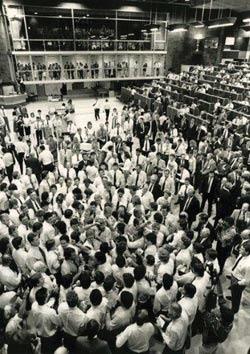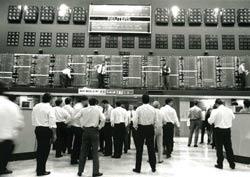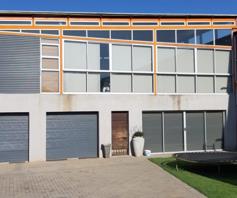Located in the country’s financial district, Sandton, the Johannesburg Stock Exchange (JSE) has a total of 394 listed companies and its market capitalisation as of 11 January 2013 was R8 620 079 096 030 (trillion).

The Johannesburg Stock Exchange was first situated on the corner of Simmonds and Commissioner Streets in the Johannesburg CBD.
Of the 394 companies, 331 are listed on the Main Board while 63 are listed on AltX Board.
The JSE is one of the top 20 exchanges in the world in terms of market capitalisation and the majority of this is based on the companies listed on the Main Board and its top 40 listed stocks, highly regarded by investors locally and globally.
The AltX Board is the alternative exchange of the JSE which provides smaller companies not yet able to list on the Main Board with a clear growth path and access to capital.
According to the JSE, there are 21 listed property companies including among others, Growthpoint Properties Limited, the largest listed property company in South Africa by market capitalisation, Redefine Properties, Vukile Property Fund, Hyprop Investments Limited, Fountainhead Property Trust, Investec Property Fund and Sycom Property Fund.
JSE history time
It all began with the discovery of gold in South Africa, which led to the establishment of the exchange in order to be able to raise money for the booming mining and financial industry.

The historic area known as “between the chains”- in Simmonds Street (Johannesburg) where trading in shares, land and property went on throughout the day and late into the night and on Sundays too.
The JSE is now 126 years old and it is South Africa’s only full service securities exchange.
Buyers and sellers are able to trade in markets such as equities (shares and stocks), equity derivatives, commodity derivatives, currency derivatives and interest rate products.
1886: Gold discovered at Langlaagte on the Witwatersrand
1887: In November, the Johannesburg Stock Exchange was established by Benjamin Woolan
1888: In January the JSE opened for business with 122 members at corner of Commissioner and Simmonds Streets.
Business soon overflowed into the “between the chains” area outside of the building

Dealing was between broker and broker in a two-way oral auction and this method continued until the JSE moved to electronic trading in 1996.
1899: October - JSE closes due to Boer War
1901: October - JSE re-opens
1904: October - JSE moves to Hollard Street
1914: October - JSE closes due to First World War
1915 :October - JSE re-opens
1937: Mid April - Great Depression Black Friday: Crash on JSE, investors lose £40 million and market value of listed mining shares drops by £168.9 million
1945: Greatest gold boom in the history of the JSE post World War II

The JSE two-way oral auction enables an experienced dealer to gauge the market in the light of general trends, even though he does not know how many shares are on offer or being sought. He merely calls the name of the share in which he wants to deal without initially revealing whether he is a buyer or a seller or the number of shares to be involved in a transaction. It is also of benefit to small broking firms with only one or two dealers, or with directors who deal themselves.
1960: Sharpeville causes overseas shareholders to disinvest, Exchange controls and "Blocked Rand” are introduced to halt the drain of capital from South Africa
1964: JSE joins the International Federation of Stock Exchanges (FIBV)
1967: JSE introduces computerised weekly clearing system
1978: JSE moves to Diagonal Street
1993: JSE becomes a member of the African Stock Exchanges Association (ASEA)

The market used to open with High Change, the alphabetical call-over in every stock, and no dealing was allowed until a stock had been called. Traders knew the opening price in all stocks as soon as it was marked on the board.
1996: June - Open outcry trading floor closed
1996: June - Order driven, centralised, automated trading system, JSE Equities Trading (JET) system introduced
1997: August - Stock Exchange News Service (SENS) introduced
1998: Introduction of internet-based services and the Emerging Enterprise Zone (EEZ), which matches seekers and providers of capital

It was mandatory for all sales prices to be recorded on the prices board when they took place at a price different from the last sale.
2001: SAFEX joins the JSE
2002: May- New trading system (JSE SETS), Information Dissemination (Infowiz) and Front End (TALX) go live
2002: June - New FTSE/JSE Africa Index Series goes live
2003: The JSE launches AltX Board.

Entrance to the Johannesburg Stock Exchange in Gwen Lane, Sandton.
2004: Launch of the Socially Responsible Investment (SRI) Index, which measures compliance by companies with triple bottom line criteria around economic, environmental and social sustainability.
2005: The JSE launches Yield-X, its market for a wide range of interest rate products allowing for the trading of both spot and derivative interest rate products on one platform with multi-lateral netting across all products.
2005: On 1 July, it demutualises and incorporates in South Africa as JSE Limited, a public unlisted company.
Existing rights holders of the JSE become its first shareholders and for the first time in its history, a person who is not an Authorised User of the JSE or a stockbroker can obtain an ownership interest in the JSE.
2006: In June 2006 the JSE Ltd lists on the Main Board
The JSE has moved away from the traditional floor-based trading to make way for modern, fully electronic trading, clearing and settlement.
With the availability of online trading, investing on the JSE is much quicker, easier and more accessible than ever before. Its website contains useful information on how to invest and some of the things you need to know about investing on the stock exchange.
The role of exchanges
The JSE explains that the first stock exchange was founded in France in the 12th century where transactions occurred in commercial bills of exchange.

The nine-storey building that houses the Johannesburg Stock Exchange in Sandton, Johannesburg. The JSE moved from Diagonal Street in Johannesburg to this building in September 2000.
According to the JSE, due to the high level distinction of primary and secondary markets, there are two main roles of a stock exchange: to act as a channel through which new capital can be raised by firms for production purposes and to provide a market on which securities can be freely traded in a regulated environment.
The actual existence of a stock market is based on the functions that it performs and these are:
1. Channeling of savings into investments undertaken by firms - this is the creation of capital resources and the allocation of these resources into the various competing investments.
2. Conversion of investment into cash
3. Evaluation of securities and management of different companies.
Primary markets relates to the sale of “new issues” or common stocks and bonds - where a financial instrument is introduced for the first time, typically when a company raises capital.
Secondary markets are where securities are bought and sold, or traded, on an ongoing basis after their initial offering, says the JSE.

On 7 June 1996 the open outcry trading floor was closed and replaced by an electronic driven, centralised, automated trading system. All trades are now carried out electronically.
The trading process
Trading on the JSE means the buying and selling of already issued shares.
Investors must remember that markets are controlled by supply and demand.
For example, if there are more sellers than buyers, the going share price will decline as sellers are forced to bid down their willingness to sell.

All trading is now electronic and the wallboard currently in the Johannesburg Stock Exchange reception indicates prices in selected shares, currencies and indices.
If buyers outnumber the sellers then prices will rise, says the JSE.
The JSE says investors do not buy shares in or through the JSE itself, but through brokering firms.
When a potential investor approaches a broker firm, discussion takes place with one of its stock brokers about the proposed investment with advice also likely to be provided.
Decisions need to be made about which shares to purchase and how much to invest, preferably with a view to medium- to long-term investment of three to five years.
Selling shares is essentially a reversal of the above. In this process, a stock broker might be asked to sell equity at the best price possible or within certain limits.
“Buying or selling limits are usually set when investors want to obtain a certain price for their shares and are prepared to wait until this price is met.” – Denise Mhlanga









